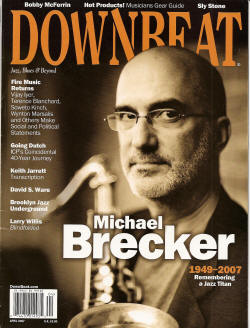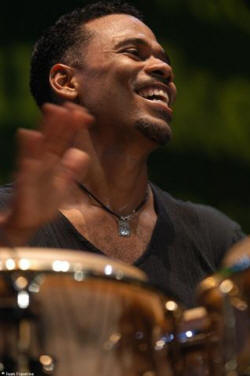APRIL 2007

Players:
Paoli Mejias - Transcending Expectations
Aaron Cohen

When
Paoli Mejias unpacks his gear to perform, he stands out from
most other Caribbean percussionists. He uses four
congas rather than the customary two.
"It's
not normal," Mejias said of his small arsenal just before a
concert at Chicago's Old Town School of Folk Music.
"But I play a lot of different types of rhythms, so that's
the best way for me to get at them. To improvise and
create the different colors that I'm looking for, it's
easier with four."
Making
musical leaps seem like easy steps has been a hallmark of
Mejias' music for some time. His 2006 disc,
Transcend, is an impressive follow-up to 2004's Mi
Tambor (both on his own label), as he mixes the sounds
of Indian tablas and Mediterranean drum patterns with the
rhythms of his home in Puerto Rico. These ideas also
come from the new compositions that he commissions from such
colleagues as saxophonists Miguel Zenón and David Sánchez.
The technique that he honed alongside some of the biggest
names in Latin jazz forms the base for Mejias' upbeat
explorations.
Born
outside of San Juan 37 years ago, Mejias heard Puerto Rican
folkloric bomba and plena everywhere when he grew up.
Yet even early on he gravitated toward different (albeit
connected) musicians like the Cuban experimental group
Irakere and New York salsa ensemble Fania All Stars.
His family was unable to afford instruments, let alone
lessons, and Mejias had a paper route to buy his first
conga.
"Playing music professionally wasn't a tradition in my
family", Mejias said. "But that made me more
determined. It's always been an upward challenge, but
a battle helps me focus. I know what I'm up against."
At the
same time, a number of established musicians helped Mejias
early on. Puerto Rico-based Afro-Cuban batá drummer
José Ramírez recommended the young percussionist to Eddie
Palmieri. Mejias debuted with Palmieri's band at New
York's Blue Note around his 21st birthday.
"It was
an amazing opportunity because Eddie asks his percussionists
to improvise and there's a lot of focus on percussionists in
his group," Mejias said. "The more I was in that
environment, the more I wanted to learn because there was so
much to internalize."
Such a
high-profile gig led to other opportunities as a sideman
with a cross section of popular bandleaders, including Tito
Puente and Marc Anthony. As Mejias spent more time
traveling and absorbing many different idioms from around
the world, he planned on incorporating those ideas for his
own music. yet even with such accolades as a Latin
Grammy jazz nomination for Mi Tambor, Mejias still faces
some expectations that his music should primarily appeal to
the feet.
"There
are two major challenges right now," Mejias said. "Relatively few percussionists have become jazz leaders.
And it's a challenge to get people to accept and demand a
new style, as I try to play with different rhythms, whether
they're in 7/8 or from Greece or India. With the
traditional Latin jazz of Mario Bauza, the focus was on the
dancer. But if people want to start dancing to my
music, that's OK."
As
Mejias contemplates making a permanent move from Puerto Rico
to New York City, he knows that the resulting increase in
opportunities carries a considerable price tag.
"New
York is a beautiful place, but it's so expensive," Mejias
said. "I'm going little by little. It's just one
more challenge."